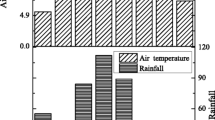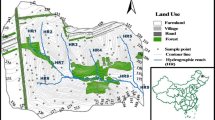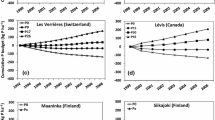Abstract
Soil phosphorus (P) concentrations above certain critical thresholds are a problem in many areas leading to its transport into surface and ground waters. Site-specific nutrient applications and the development of nutrient management plans for farms would help to optimize nutrient applications, meet crop requirements and take into consideration current soil nutrient status. In Northern Ireland, high concentrations of soil P are common, whereas low concentrations of soil potassium (K) and sulphur (S) have been reported in many silage fields. This study used grid and transect soil sampling to measure within- and between-field spatial variation in soil Olsen-P status across a 50-ha permanent grassland site used for silage production. Soil phosphorus indices ranged from Index 1 to Index 4 within single fields. The spatial patterns of soil P across fields suggested that there was scope for site-specific P fertilizer applications, with variable quantities of P being applied to different fields and within individual fields. Site-specific nutrient management has the potential to reduce excess P applications in some areas and avoid deficiencies in others, thereby minimizing environmental problems and optimizing yield.






Similar content being viewed by others
References
Bloem, E., Haneklaus, S., Sparovek, G., & Schnug, E. (2001). Spatial and temporal variability of sulphate concentration in soils. Communications in Soil Science and Plant Analysis, 32, 1391–1403. doi:10.1081/CSS-100104201.
Bramley, R. G. V., & Janik, L. J. (2005). Precision Agriculture demands a new approach to soil and plant sampling and analysis–examples from Australia. Communications in Soil Science and Plant Analysis, 36, 9–22. doi:10.1081/CSS-200042958.
Bramley, R. G. V., & White, R. E. (1991). An analysis of the variability in the activity of nitrifiers in a soil under pasture. I. Spatially dependent variability and optimum sampling strategy. Australian Journal of Soil Research, 29, 95–108. doi:10.1071/SR9910095.
Brevik, E. C., Fenton, T. E., & Lazari, A. (2006). Soil electrical conductivity as a function of soil water content and implications for soil sampling. Precision Agriculture, 7, 393–404. doi:10.1007/s11119-006-9021-x.
Corwin, D. L., & Lesch, S. M. (2003). Applications of soil electrical conductivity to precision agriculture: Theory, principles and guidelines. Agronomy Journal, 95, 455–471.
Cuttle, S. P. (1992). Spatial variability and the use of ceramic cup samplers to measure nitrate leaching from pastures. Aspects of Applied Biology, 30, 71–74.
Dampney, P. M. R., Froment, M. A., & Dawson, C. J. (1997). The variability of pH and available phosphorus, potassium and magnesium in soils within arable fields in England. In J. V. Stafford (Ed.), Precision agriculture ‘97 (pp. 79–86). Melksham, Wiltshire, UK: BIOS Scientific Publishers Ltd.
ESRI (Environmental Systems Research Institute) Inc. (1999). Arc View GIS, V3.2. Redlands, CA, USA.
ESRI (Environmental Systems Research Institute) Inc. (2007). ArcMap, V9.2. Redlands, CA, USA.
Foy, R. H., Bailey, J. S., & Lennox, S. D. (2002). Mineral balances for the use of phosphorus and other nutrients by agriculture in Northern Ireland from 1925 to 2000––methodology, trends and impacts of losses to water. Ireland Journal of Agricultural and Food Chemistry, 41, 247–263.
Foy, R. H., Smith, R. V., Jordan, C., & Lennox, S. D. (1995). Upward trend in soluble phosphorus loadings to Lough Neagh despite phosphorus reduction at sewage treatment works. Water Research, 29, 1051–1063. doi:10.1016/0043-1354(94)00259-A.
Franzen, D. W., & Peck, T. R. (1995). Field soil sampling density for variable rate fertilisation. Journal of Production Agriculture, 8, 568–574.
Frogbrook, Z. L. (1999). The effect of sampling intensity on the reliability of predictions and maps of soil properties. In J. V. Stafford (Ed.), Precision agriculture ‘99 (pp. 71–80). Sheffield, UK: Sheffield Academic Press.
Frogbrook, Z. L., & Oliver, M. A. (2007). Identifying management zones in agricultural fields using spatially constrained classification of soil and ancillary data. Soil Use and Management, 23, 40–51. doi:10.1111/j.1475-2743.2006.00065.x.
Gamma Design. (2005). Geostatistics for the environmental science. Michigan, USA: Plainwell.
Godwin, R. J., & Miller, P. C. H. (2003). A review of the technologies for mapping within-field variability. Biosystems Engineering, 84, 393–407. doi:10.1016/S1537-5110(02)00283-0.
Jarvis, S. C., & Pain, B. F. (Eds.). (1997). Gaseous emissions from grasslands. Wallingford, UK: CAB International.
Jordan, C., Shi, Z., Bailey, J. S., & Higgins, A. J. (2003). Sampling strategies for mapping ‘within-field’ variability in the dry matter yield and mineral nutrient status of forage grass crops in cool temperate climes. Precision Agriculture, 4, 69–86. doi:10.1023/A:1021815122216.
Jordan, C., Smith, R. V., Hamill, K. P., & Higgins, A. J. (2002). The influence of parent material and livestock intensification on plant-available phosphorus values by the Olsen method in Northern Ireland. Soil Use and Management, 18, 208–215. doi:10.1079/SUM2002140.
Kerry, R., & Oliver, M. A. (2003). Variograms of ancillary data to aid sampling for soil surveys. Precision Agriculture, 4, 261–278. doi:10.1023/A:1024952406744.
Kerry, R., & Oliver, M. A. (2004). Average variograms to guide soil sampling for land management. International Journal of Applied Earth Observation and Geoinformation, 5, 307–325. doi:10.1016/j.jag.2004.07.005.
Kerry, R., & Oliver, M. A. (2007). Comparing sampling needs for variograms of soil properties computed by the method of moments and residual maximum likelihood. Geoderma, 140, 383–396. doi:10.1016/j.geoderma.2007.04.019.
Kerry, R., & Oliver, M. A. (2008). Determining nugget:sill ratios of standardized variograms from aerial photographs to krige sparse soil data. Precision Agriculture, 9, 33–56. doi:10.1007/s11119-008-9058-0.
Kitanidis, P. K. (1983). Statistical estimation of polynomial generalized covariance functions and hydrologic applications. Water Resources Research, 19, 909–921. doi:10.1029/WR019i004p00909.
Kitanidis, P. K., & Lane, R. W. (1985). Maximum likelihood parameter estimation of hydrologic spatial processes by the Gauss-Newton method. The Journal of Hydrology (Amst), 79, 53–71. doi:10.1016/0022-1694(85)90181-7.
Lark, R. M., & Webster, R. (2006). Geostatistical mapping of geomorphic variables in the presence of trend. Earth Surface Processes and Landforms, 31, 862–874. doi:10.1002/esp.1296.
Lin, H., Wheeler, D., Bell, J., & Wilding, L. (2005). Assessment of soil spatial variability at multiple scales. Ecological Modelling, 182, 271–290. doi:10.1016/j.ecolmodel.2004.04.006.
MAFF. (Ministry of Agriculture Fisheries and Food). (2000). Fertiliser recommendations for agricultural and horticultural crops. MAFF/ADAS Reference Book 209 7th ed. London, UK: HMSO.
Matheron, G. (1965). Les Variables Régionalisées et leur Estimation: une Application de la Théorie de Fonctions Aléatoires aux Sciences de la Nature. Paris: Masson et Cie.
Matheron, G. (1971). The theory of regionalized variables and its applications. Cahiers du Centre de Morphologie Mathematique (Vol. 5). Fontainebleau, France.
McBratney, A. B., & Pringle, M. J. (1999). Estimating average and proportional variograms of soil properties and their potential use in precision agriculture. Precision Agriculture, 1, 125–152. doi:10.1023/A:1009995404447.
Olsen, S. R., Cole, R. V., Watanabe, F. S., & Dean, L. A. (1954). Estimation of available phosphorus in soils by extraction with sodium bicarbonate. Washington, DC: U.S. Government Printing Office, USDA Circular 939.
OSNI. (2006). Ortho 10 m digital terrain model, 2006. Belfast, UK: Ordnance Survey for Northern Ireland.
Pardo-Igúzquiza, E. (1997). MLREML: A computer program for the inference of spatial covariance parameters by maximum likelihood and restricted maximum likelihood. Computers and Geosciences, 23, 153–162. doi:10.1016/S0098-3004(97)85438-6.
Patterson, H. D., & Thompson, R. (1971). Recovery of interblock information when block sizes are unequal. Biometrika, 58, 545–554. doi:10.1093/biomet/58.3.545.
Payne, R. W. (Ed.). (2007). The guide to GenStat release 10––part 2: Statistics. VSN International: Hemel Hempstead.
Rhoades, J. D., Corwin, D. L., & Lesch, S. M. (1999). Geospatial measurements of soil electrical conductivity to assess soil salinity and diffuse salt loading from irrigation. In D. L. Corwin, K. Loague, & T. R. Ellsworth (Eds.), Assessment of non-point source pollution in the vadose zone. geophysical monograph (Vol. 108, pp. 197–215). Washington, DC: AGU.
Sharpley, A. N., & Withers, P. J. A. (1994). The environmentally sound management of agricultural phosphorus. Fertilizer Research, 39, 133–146. doi:10.1007/BF00750912.
Smith, R. V., Foy, R. H., & Lennox, S. D. (1994). The application of mathematical modelling techniques to evaluate the impact of phosphorus reduction on phosphate loads to Lough Neagh. In V. Barnett & K. F. Turkman (Eds.), Statistics for the environment 2: Water related issues (pp. 271–284). Chichester, UK: Wiley.
Smith, V. H., Tilman, G. D., & Nekola, J. C. (1999). Eutrophication: Impacts of excess nutrient inputs on freshwater, marine and terrestrial ecosystems. Environmental Pollution, 100, 179–196. doi:10.1016/S0269-7491(99)00091-3.
Viscarra-Rossel, R. A., & McBratney, A. B. (1998). Soil chemical analytical accuracy and costs: Implications from precision agriculture. Australian Journal of Experimental Agriculture, 38, 765–775. doi:10.1071/EA97158.
Webster, R., & Cuanalo de La, C. H. E. (1975). Soil transect correlograms of north Oxfordshire and their interpretation. Journal of Soil Science, 26, 176–194. doi:10.1111/j.1365-2389.1975.tb01942.x.
Webster, R., & Oliver, M. A. (1992). Sample adequately to estimate variograms of soil properties. Journal of Soil Science, 43, 177–192. doi:10.1111/j.1365-2389.1992.tb00128.x.
Webster, R., & Oliver, M. A. (2007). Geostatistics for environmental scientists (2nd ed.). Chichester, UK: Wiley.
West, C. P., Mallarino, A. P., Wedin, W. F., & Marx, D. B. (1989). Spatial variability of soil chemical properties in grazed pastures. Soil Science Society of America Journal, 53, 784–789.
Whelan, B. M., & McBratney, A. B. (2000). The “null hypothesis” of precision agriculture management. Precision Agriculture, 2, 265–279. doi:10.1023/A:1011838806489.
Withers, P. J. A., & Lord, E. I. (2002). Agricultural nutrient inputs to rivers and groundwaters in the UK: Policy, environmental management and research needs. Science of the Total Environment, 282–283, 9–24. doi:10.1016/S0048-9697(01)00935-4.
Wollenhaupt, N. C., Wolkowski, R. P., & Clayton, M. K. (1994). Mapping soil test phosphorus and potassium for variable-rate fertilizer applications. Journal of Production Agriculture, 7, 441–448.
Yost, R. S., Uehara, G., & Fox, R. L. (1982). Geostatistical analysis of soil chemical properties of large land areas. I. Semivariograms. Soil Science Society of America Journal, 46, 1028–1032.
Acknowledgements
S. McCormick gratefully acknowledges the receipt of a PhD studentship from the Department of Agriculture and Rural Development for Northern Ireland, and the staff within the Agri-Environment Branch of the Agri-Food and Biosciences Institute for their assistance with field and laboratory work.
Author information
Authors and Affiliations
Corresponding author
Rights and permissions
About this article
Cite this article
McCormick, S., Jordan, C. & Bailey, J.S. Within and between-field spatial variation in soil phosphorus in permanent grassland. Precision Agric 10, 262–276 (2009). https://doi.org/10.1007/s11119-008-9099-4
Published:
Issue Date:
DOI: https://doi.org/10.1007/s11119-008-9099-4




